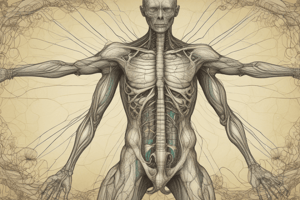Podcast
Questions and Answers
Lymph is most similar to:
Lymph is most similar to:
- Blood plasma (correct)
- Red blood cells
- Saline solution
- Interstitium fluid
Lymphatic collecting vessels are most closely associated with:
Lymphatic collecting vessels are most closely associated with:
- Nerves
- Arteries
- Veins
- Capillary beds (correct)
Once collected, lymph is returned to:
Once collected, lymph is returned to:
venous circulation
What do lymphatic vessels do?
What do lymphatic vessels do?
Which of the following is NOT a part of the lymphatic system?
Which of the following is NOT a part of the lymphatic system?
Antibodies are produced by _______.
Antibodies are produced by _______.
Which of the following lymphoid tissues/organs does not contain reticular connective tissue?
Which of the following lymphoid tissues/organs does not contain reticular connective tissue?
Which of the following are considered the primary immune system cells?
Which of the following are considered the primary immune system cells?
Which of the following is NOT a lymphoid cell?
Which of the following is NOT a lymphoid cell?
Which of the following is a role of lymph nodes?
Which of the following is a role of lymph nodes?
Which of the following is not a lymphoid tissue/organ?
Which of the following is not a lymphoid tissue/organ?
The ________ is (are) the most likely to become infected.
The ________ is (are) the most likely to become infected.
What is/are the principal lymphoid organ(s) in the body?
What is/are the principal lymphoid organ(s) in the body?
The thymus functions strictly in maturation of T cells.
The thymus functions strictly in maturation of T cells.
Where are Peyer's patches located?
Where are Peyer's patches located?
Which of the following is NOT a part of the MALT?
Which of the following is NOT a part of the MALT?
Which of the following is/are the simplest lymphoid organ(s)?
Which of the following is/are the simplest lymphoid organ(s)?
Which lymphoid organ serves as the site where T lymphocytes become immunocompetent T cells?
Which lymphoid organ serves as the site where T lymphocytes become immunocompetent T cells?
Which lymphoid organ provides a site for lymphocyte proliferation and immune surveillance and response and provides blood-cleansing functions?
Which lymphoid organ provides a site for lymphocyte proliferation and immune surveillance and response and provides blood-cleansing functions?
Lymph arrives to the lymph nodes via efferent lymphatic vessels.
Lymph arrives to the lymph nodes via efferent lymphatic vessels.
The first lymphoid organ to appear in development is (are) the:
The first lymphoid organ to appear in development is (are) the:
Where are Peyer's patches located?
Where are Peyer's patches located?
Flashcards are hidden until you start studying
Study Notes
Lymphatic System Overview
- Lymph resembles blood plasma in composition.
- Lymphatic collecting vessels are closely associated with capillary beds for fluid collection.
- Lymph is returned to the bloodstream through venous circulation.
Lymphatic Vessels and Function
- Lymphatic vessels play a critical role in returning excess tissue fluid to the bloodstream.
- Blood vessels are not considered part of the lymphatic system, unlike lymphatic vessels, lymph, and lymph nodes.
- Lymph nodes filter lymph, a pivotal function contributing to immune response.
Immune System Cells and Functionality
- Plasma cells are responsible for antibody production.
- Lymphocytes are recognized as the primary cells of the immune system.
- Eosinophils are not categorized as lymphoid cells, unlike macrophages, reticular cells, and dendritic cells.
Lymphoid Organs and Tissues
- The thymus lacks reticular connective tissue, differentiating it from other lymphoid organs.
- The principal lymphoid organs in the body include lymph nodes, with the spleen also fulfilling significant immune functions.
- Tonsils are identified as the simplest lymphoid organs, while Peyer's patches reside in the distal portion of the small intestine.
Development and Maturation
- The thymus gland is critical for T cell maturation, ensuring immunocompetency.
- The first lymphoid organs to develop are lymph nodes, highlighting their foundational role in the immune system.
MALT and Other Lymphoid Structures
- Lymph nodes do not form part of the Mucosa-Associated Lymphoid Tissue (MALT), which includes tonsils, the appendix, and Peyer's patches.
- The spleen serves multiple roles, including lymphocyte proliferation, immune surveillance, and blood cleansing.
Additional Facts
- The palatine tonsils are the most likely site for infection among the tonsil types.
- Lymph moves into lymph nodes via afferent lymphatic vessels, contrary to the misbelief that it arrives via efferent vessels.
Studying That Suits You
Use AI to generate personalized quizzes and flashcards to suit your learning preferences.




